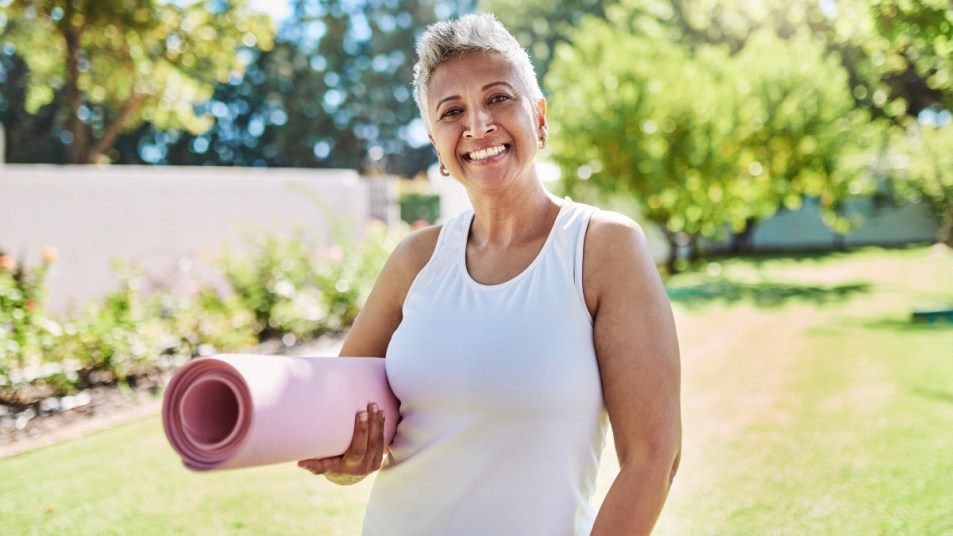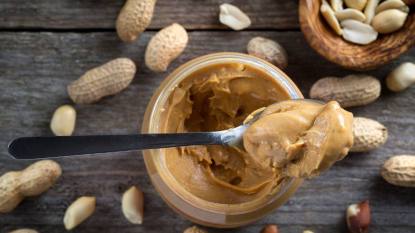Interested in Yoga? Experts Explain the Different Types + the Mind-Body Benefits You Can Expect
From hot Bikram yoga to soothing restorative yoga, this is your guide to 7 popular practices

We’re all generally familiar with yoga. The gentle movements — paired with deep breathing and meditation — aim to connect the mind, body and spirit. The ultimate goal is to enhance your health and wellbeing through regular practice. But with so many yoga variations out there, how do you know which one is right for you? Here, we break down the types of yoga explained and the health perks you can expect from working on poses like your downward dog.
Types of yoga: The history explained
Yoga is an ancient physical, mental and spiritual practice that originated in India thousands of years ago. Meaning to join or unite in Sanskrit, yoga delivers a wealth of mind-body benefits. As for the health perks? It improves strength, endurance, balance and flexibility. Plus it tames stress and anxiety. So it’s no surprise that yoga has now become wildly popular across the globe. In fact, millions of people over the last decade have participated in an annual International Day of Yoga!
7 popular types of yoga explained
Whether you’re new to yoga or want to expand your practice, we asked experts to explain some of the most popular types of yoga. Here’s how they differ, plus how they can improve your well-being.
1. Vinyasa Yoga
Multiple forms of yoga fall under the category of Vinyasa, which is one of the most popular contemporary forms. They each adopt an overall dynamic and energetic style, explains certified yoga instructor Taryn Lagonigro, founder of Iris Yoga. Vinyasa means “to place in a special way,” she says. In this case, that relates to yoga postures.
“Vinyasa flow is sometimes compared to dancing because of the flow from one position to the other,” says Lagonigro. “The linking of movement with breath creates a sense of harmony through a moving meditation. Vinyasa flow doesn’t follow a set sequence of poses. Therefore, classes are often a creative blend of postures as determined by the teacher’s experience and inspiration.”
Indeed, Vinyasa is often referred to as “flow” in the yoga space. Holistic therapist Jenny Flora Wells, MSW, LSW, ACSW adds that Vinyasa is all about purposeful movement that follows alignment and postures, transitions and yoga sequencing. It also focuses on the pattern of the breath in relation to the pose or posture, she says.
2. Yin Yoga
Compared to Vinyasa, Yin Yoga moves at a slower pace. You hold each each posture for a longer period of time (three to five minutes), and you’re typically in seated positions. It gently stretches the body’s connective tissues, which makes it especially ideal for people with mobility limitations or stiffness.
“It’s great for flexibility and joint health, relaxation and meditation and a balanced energy flow,” says Carlie Gasia, Certified Wellness Coach at Sleepopolis.
Related: The 5 Best Chair Exercises for Back Pain That Are Easy to Do Right at Home
3. Restorative Yoga

The point of restorative yoga is right in the name! It helps you feel relaxed and rejuvenated. Typically, you’ll use props in restorative yoga to offer support as you move through gentle poses held for extended periods.
“Some props include bolsters, blankets and eye bags to help your body truly surrender,” says Lagonigro. “The classes are relaxed. You’re supposed to let gravity do most of the work, since most of the poses consist of lying down. Restorative poses have a particular ability to leave us nourished and well rested, resulting in reduced stress levels. The poses in restorative yoga are adapted from supine, inverted or seated yoga postures.”
Wells explains that restorative yoga helps regulate the parasympathetic nervous system, which controls the body’s ability to relax. It’s the opposite of the “fight or flight” state. Restorative yoga can help bring the body “to a place of safety,” Wells adds.
4. Bikram Yoga
Trendy Bikram yoga will have you breaking a sweat. It features a sequence of set poses in a sauna-like room, typically set to 105 degrees and 40% humidity. All Bikram yoga classes follow the exact same format lasting 90 minutes. During that time, the same 26 postures are completed and each are performed twice, Lagonigro explains.
Gasia says the heated atmosphere promotes detoxification and flexibility. In addition to the 26 poses, two breathing exercises are included. Lagonigro says this type of yoga can help with flexibility, strength, balance and cardiovascular health, too.
5. Kundalini Yoga
Kundalini yoga helps awaken energy from the base of the spine through different types of breathing techniques and postures. Spirituality is very prominent in this practice, as sessions often include chanting, mantra, meditation and sometimes even singing.
6. Iyengar Yoga
As Gasia explains, “Iyengar yoga focuses on precise alignment and uses props like blocks, straps and bolsters. Common movements include standing poses, inversions, backbends and seated poses. This practice improves posture and alignment, increases awareness and concentration and can even reduce chronic pain.”
Iyengar yoga also focuses closely on sequencing, stability and timing while honoring your boundary setting, Wells adds.
7. Hatha Yoga
This type of yoga is ideal for beginners, Wells says. It’s viewed as interweaving you with the sun and moon. Hatha achieves balance between the mind and body through postures, breath control and meditation.
Types of yoga explained: Which is right for you?

Deciding which practice is a match for you shouldn’t be frustrating or overwhelming. Lagonigro advises trying different types of yoga multiple times in order to see which makes you feel your best from both a mental and physical standpoint. You might not know intuitively from one class if a style is going to work for you, she says. So give yourself some grace and keep trying until you start to find your way.
“When I first tried hot yoga, for example, I left saying that I would never do it again,” Lagonigro says. “Yet now it’s my favorite type of yoga to do. The most important thing about starting a yoga practice is going in with an open mind. So often we hear ‘I can’t touch my toes!’, which is not the prerequisite to doing yoga. Maybe you will never touch your toes, but you can still enjoy all the benefits of yoga for your mind and your body.”
Choosing different types of yoga for your goals
“For those with a physical restriction [permanent or temporary], you may want to seek out Restorative Yoga or a gentle Vinyasa class,” Lagonigro says. You can also think proactively about your health and wellness goals.
If you want to build strength, flexibility or cardiovascular health, you might opt for a more intense type of yoga such as Vinyasa or Bikram, Gasia says. Want something gentler to calm your mind or reduce stress? Consider Restorative, Yin Yoga or Hatha. And if you’re interested in spiritual practice and energy work, Kundalini might be ideal.
Discover more total-body benefits of yoga:
Yoga for Back Pain Can Deliver Relief Even When Meds Fail — Here’s How
Yoga for Menopause Helps Tame Hot Flashes, Irritability, Fatigue and More, Experts Agree
“Two Simple Chair Yoga Moves Saved Me From Chronic Pain and Constant Falls!”
This content is not a substitute for professional medical advice or diagnosis. Always consult your physician before pursuing any treatment plan.













